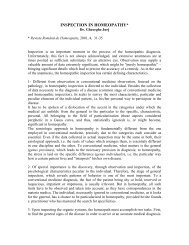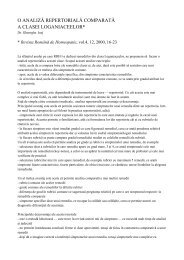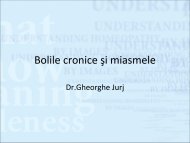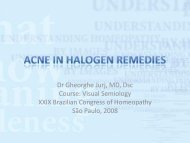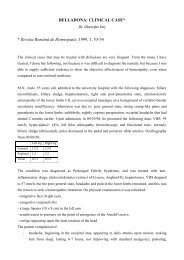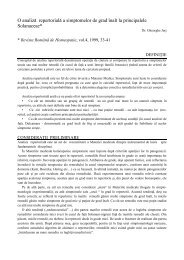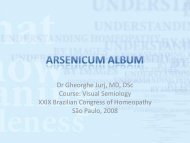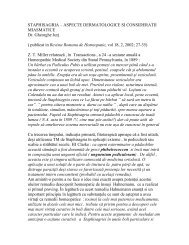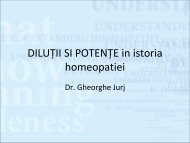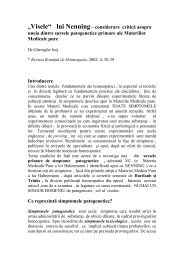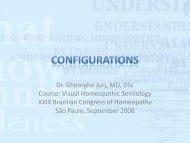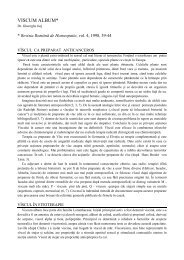homeopathic treatmen.. - Dr. Gheorghe Jurj - Homeopatie
homeopathic treatmen.. - Dr. Gheorghe Jurj - Homeopatie
homeopathic treatmen.. - Dr. Gheorghe Jurj - Homeopatie
- No tags were found...
Create successful ePaper yourself
Turn your PDF publications into a flip-book with our unique Google optimized e-Paper software.
Individualization of lesions However, to a closer specifically<strong>homeopathic</strong> look, they may be verydifferent by their qualities: localization,morphology, modalities, etc. These may have the greatest interest forindividualization as deviations from thegeneral aspect
Individualization1. observation of the patient’s behavior2. coexistence of manifestations in otherareas, pathological or not3. general context of the patient, includingpersonal and family antecedentst
Method Observational study. Private practice, 8 years. Children with diagnosis of AD made by adermatologist and full records for 6 months(minimum) The <strong>homeopathic</strong> approach was singleremedy prescription, chosen according thecriteria of <strong>homeopathic</strong> individualization. Other therapeutic means were suspended,except in case of acute diseases.
Evaluation1. Clinical2. Graphic record (video and photographs)* Caretakers were instructed to observethe evolution of the disease and tonotice all modifications, both on the skinand the general state.
Outcome CRITERIA1) General state of the patient (non suppressive <strong>treatmen</strong>t)2) Evolution of objective signs. GROUPS:1. Good: disappearance of all signs for a period of 6months. (100%)2. Regular: significant amelioration of the eruption inextension and time, eventual disappearance for periodsshorter than 6 months but occasional reappearance. (50-99%)3. Poor: oscillatory and instable evolution of the eruption inextension and time, with periods of amelioration andaggravation. (less than 50%)
Results35 children, age 6 months to 13 years old
Name Age Sex Remedy, potency, Agg.* Evolution** Results***scaleA.S. 2 F Coralium rubrum + Agg. 30 CH;100% G30, 200 CHamel. at 200 CHA.H. 2 F Quartz 10, 15D - GB.V. 12 M Lyc 1, 2 LM - Progressive amel. R80 %B.R. 6 M Oleander 15,30CH;Sulph 1, 2, 3 LM- Oleander: noimprovement, amel90 % with .RB.M. 13 F Graphites 200CH; ++ Agg after Graph; RAm-c 30 D;Graph 1000Kasthma crisis,relieved by Am-c;amel 80 % withGraph 1000KC.A. 7 M Sulph 1, 2, 3LM;100% amel. Sulph.,Calc 6D; Sulph 1,23LM 2, +after Calc 6D(dentition),followed by amel100%C.D. 1 M Calc lactica 6D,- Treatment duringrepeatedbreast feeding,100% amelC.C . 2 M Sulph 1LM, Lyc 1, - Amel. Sulph 1Lm G2 LM, Sulph 3 LM with mental agg;better mental afterLyc; Sulph 3LM,amel 100%C. F. 1 F Calc 1000K, 30CH,Calc 10000KC.V. 2 M Calc 10D, Cham30, 200CH++ Agg. Calc 1000K,amel 30, then 100%amel Calc 10000K+ Agg mental stateand AD Calc; amel80 % Cham 30, and100% Cham 200C. T. 1 M Phos 1, 2, 3 LM - Slow andprogressive amel.D. R. 1 M Calc lactica 4, 6D - Fast amel of DA,no more rinitisD. M. 2 M Lyc 200CH, Sulph - No amel. Lyc.;1, 2, 3LMslow amel SulphGGGGGGR
D .O. 1 M Calc 200CH, Calcnitr 10, 15, 30D- Associated lactoseintolerance, no resultCalc, amel 100%Calc-nitrGF.G. 1 F Lyc 1, 2LM repeated3 times- Associatedintolerance gluten,both amel. Lyc.F. H. 2 M Calc 10, 15D, 200CH - Amel. recurrentbronchitis 10, 15D;amel DA CH 200F.R. 2 M Calc 10, 15D, Sulph1LM, Calc 30D ++G. A. 1 F Phos 30, 200CH,1000KH. R 1 F Cham 200CH, 1000KAgg. Sulph; Calc 10Damel. hypotonicseizures; Calc 30D.amel. DA- Progressive amel. ofDA, no morebronchiolitis.+ Short agg. after 200but mentally better,100% amel. 1000KI. R 2 M Calc 30D; 30CH,Calc 200CH- General amel. Calc;DA improvedK. M 1 F Graph 30CH, 1, 2LM - Progressive generalamel.L. O 2 F Sulph 200CH, Merc ++ Agg. otitis Sulph30D, Sulph 1, 2, 3LMCH200, treated withMerc, then slowamel. Sulph LMM. A 3 M Calc 200CH - General amel. ButrecurrencesM. G. 1 F Ars 30, 200CH, 1LM + Agg. DA 30, amelfears, then fast amel.200, 100% LMN. A 2 M Apis 30CH, Phos200CH, 1, 2LM- No response Apis buttonsillitis, progressiveamel. PhosRGRGGRGRRGG
N.C 1 M Ant-c 200CH - Fast improvement at1 monthOM O. 1 F Med 200CH,+ Slight agg. thenRrepeated; 1000K100% amel., agg.after the 2 y.o.vaccination, Med.1000K amelP. A. 2 M Phos 200CH, 1000+ No result Phos; afterGK; Zinc 1000KZinc, agg. then amel100%P M. 3 M Nat-s 1, 2LM,200CH- Associatedspasmodicbronchitis. Amel.LM, but reappearedafter 1 year, amel.200.P. I 2 F Sulph 1, 2LM - Progressive amel. GR. M 2 M Sulph 1, 2LM, then3, 4LMAmel. 100% 1,2;reappeared 1 yearfollowingvaccination; amel.3,4.S. D. 1 M Sulph 1000K, 30CH,1000KT. A. 6 M Phos 1000K, Ipeca10D, Phos 1, 2LM++ Agg. Sulph, amel.30, amel.100%1000K++ Short agg. Phos1000K, followed byasthmatic crisis,Ipeca, than 100%after Phos LMT. A.M 1 F Calc lactica 4D - Fast amel. GGRRGGV. C 1 M Thuj 30CH, Sulph 1,2, 3LM- No result Thuj, slowamel. at SulphR
Outcome
Remedies
Aggravation Homeopathic aggravation was observedin 12 patients (34.20%). The remedies most frequently involvedwere Sulphur and Calcarea carbonica.
Dilutions Remedies were prescribed in variousdilutions: x, cH, K and LM. The best results and less aggravationwere obtained with LM.
Problems1. Natural evolution of diseaseAD presents periods of remission andrecurrence, due to known or unknownfactors.We rated as positive only cases whereimprovement was directly related to theadministration of the <strong>homeopathic</strong>remedy
Problems2. Homeopathic aggravation We considered as <strong>homeopathic</strong>aggravations only those directly relatedto the intake of the remedy, lasting for amaximum of one month and followed byclear improvement of both the objectiveand subjective signs. Aggravations longer than one monthwere considered as poor outcome andrequiring a new prescription. p
It is possible for aggravation to be consideredas a sign of global reaction, in the case ofpatients known as particularly sensitive toexternal influences, including highly dilutedremedies. In some cases, the initial aggravation wasfollowed by stable and continuousimprovement. In few others, the improvementof the skin condition was followed by anaggravation in other areas, suggesting asuppressive <strong>treatmen</strong>t. For all these, larger studies are stronglyrequested.
Problems3. Time limit to rate outcomes First prescriptions may have no effect,and one or more changes of remediesand/or potencies may be required. For the purposes of the present studywe established a maximum of 3 possiblechanges of remedies.
Problems4. Clinical presentation of ADSome cases proved to be moreresistant than others, and required alonger period of <strong>treatmen</strong>t.However even cases with extendedlesions proved to respond well toindividualized <strong>homeopathic</strong> <strong>treatmen</strong>t.
Problems5. Onset of <strong>treatmen</strong>t The rate of positive results seemed to bedirectly related to the precocity in the onset ofthe <strong>homeopathic</strong> <strong>treatmen</strong>t and the age of thepatient when the <strong>treatmen</strong>t was initiated. Treatment started in the first months after theonset of the disease and at an early age,seemed to result in a higher rate of positiveoutcomes when the remedy was well chosen.
Final remarks This is an observational studyconducted in a private practice. Although it does not comply with thestrict criteria of clinical trials, it suppliesdata on the effectiveness of homeopathyon AD within the specific terms of thismedical approach. It has been reported the lack of relevantstudies (Boralevi, 2005).Boralevi F What additional measures should be recommended in atopicBoralevi F. What additional measures should be recommended in atopicdermatitis in children? Ann Dermatol Venereol 2005;132 (Spec 1): 1S79-85.
As the aim is to treat the patient as awhole and not to suppress pathology,the inclusion of artificial rules which maynot fit the <strong>homeopathic</strong> framework maylead to inaccurate results. (Hughes etal., 2007; Ponvert, 2004; Smolle, 2003).Hughes R, Ward D, Tobin AM, Keegan K, Kirby B. The use of alternative medicine in pediatric patientswith atopic dermatitis. Pediatr Dermatol 2007;24(2):118-120.Ponvert C. What’s new in pediatric allergology? A review of the international literature from October 2002to September 2003. Arch Pediatr 2004;11(12):1525-41.Smolle J. Homeopathy in dermatology. Dermatol Ther 2003;16(2):93-97.
Conclusions The results of this study suggest thatindividualized homeopathy is effective inthe <strong>treatmen</strong>t of children with atopicdermatitis; That in a significant fraction of the casesimprovement was preceded by<strong>homeopathic</strong> aggravation; That a temporary lack of improvement wasobserved after the use of an unsuitableremedy, followed by a positive i answer afterrevaluation of the case and prescription ofa new remedy.




